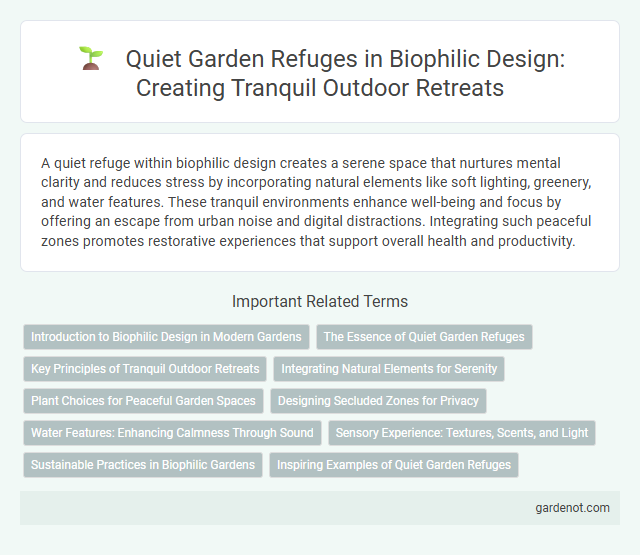A quiet refuge within biophilic design creates a serene space that nurtures mental clarity and reduces stress by incorporating natural elements like soft lighting, greenery, and water features. These tranquil environments enhance well-being and focus by offering an escape from urban noise and digital distractions. Integrating such peaceful zones promotes restorative experiences that support overall health and productivity.
Introduction to Biophilic Design in Modern Gardens
Biophilic design in modern gardens creates quiet refuges that enhance mental well-being by integrating natural elements such as native plants, water features, and natural materials. These serene spaces promote relaxation and focus by mimicking environments where humans naturally thrive, reducing stress and improving cognitive function. Incorporating biophilic principles in garden design fosters deeper connections with nature, encouraging mindfulness and restorative experiences.
The Essence of Quiet Garden Refuges
Quiet garden refuges in biophilic design create essential sanctuaries that reduce urban noise pollution and enhance mental well-being. These spaces integrate natural elements like dense foliage, water features, and soft ground cover to absorb sound and foster tranquility. Studies show exposure to such environments lowers stress hormones and improves cognitive focus by reestablishing connection with nature.
Key Principles of Tranquil Outdoor Retreats
Biophilic design incorporates quiet refuge as a key principle by creating tranquil outdoor retreats that minimize sensory overload and enhance stress reduction. Elements such as natural soundscapes, soft lighting, and secluded green spaces foster mental restoration and deep relaxation. Integrating native plants, water features, and ergonomic seating supports a harmonious connection to nature, promoting overall well-being.
Integrating Natural Elements for Serenity
Integrating natural elements such as indoor plants, water features, and natural wood textures creates a quiet refuge that enhances mental clarity and reduces stress. Biophilic design principles prioritize the incorporation of daylight, organic shapes, and nature-inspired materials to foster serenity in interior spaces. This approach supports emotional well-being by establishing a calming environment that resonates with innate human connections to nature.
Plant Choices for Peaceful Garden Spaces
Choosing plants with soft textures, muted colors, and gentle fragrances enhances quiet refuge in biophilic garden design by promoting calm and relaxation. Native species like lavender, ferns, and ornamental grasses create soothing sensory experiences that reduce stress and improve mental clarity. Incorporating evergreen shrubs and bamboo provides year-round privacy and noise buffering, reinforcing a serene outdoor sanctuary.
Designing Secluded Zones for Privacy
Creating quiet refuges in biophilic design involves integrating secluded zones that prioritize privacy through natural barriers such as dense foliage, sound-absorbing materials, and water features. These spaces enhance mental well-being by reducing sensory overload and fostering restorative experiences within urban or indoor environments. Strategic placement of greenery and natural textures effectively minimizes noise pollution and visual distractions, promoting focused relaxation and concentration.
Water Features: Enhancing Calmness Through Sound
Water features in biophilic design create a quiet refuge by producing gentle, natural sounds that mask urban noise and reduce stress. The rhythmic flow of water promotes mental clarity and relaxation, boosting focus and overall well-being. Incorporating fountains, streams, or small ponds enhances calmness and fosters a deeper connection to nature within indoor and outdoor spaces.
Sensory Experience: Textures, Scents, and Light
In biophilic design, a quiet refuge enhances sensory experience by incorporating natural textures like wood, stone, and soft fabrics that evoke tactile comfort and connection to nature. Scents from essential oils, fresh plants, and natural materials stimulate olfactory senses, promoting relaxation and well-being. Soft, diffused natural light or adjustable daylight-mimicking fixtures support circadian rhythms and create a calming atmosphere essential for mental focus and stress reduction.
Sustainable Practices in Biophilic Gardens
In biophilic gardens, quiet refuges are created through sustainable practices such as using native plants that require minimal irrigation and chemical inputs, promoting biodiversity while conserving resources. Incorporating permeable pathways and rainwater harvesting systems further enhances environmental sustainability by reducing runoff and supporting natural water cycles. These strategies not only foster a tranquil atmosphere but also contribute to the ecological health and resilience of outdoor spaces.
Inspiring Examples of Quiet Garden Refuges
Quiet garden refuges such as the Japanese Zen gardens at Ryoan-ji and the contemplative spaces at the Huntington Library exemplify biophilic design by integrating natural elements to foster mindfulness and tranquility. These serene environments utilize water features, native plants, and subtle soundscapes to create sensory harmony that reduces stress and improves cognitive focus. Incorporating such quiet refuges in urban landscapes supports mental well-being by reconnecting individuals with restorative natural settings.
Quiet refuge Infographic

 gardenot.com
gardenot.com